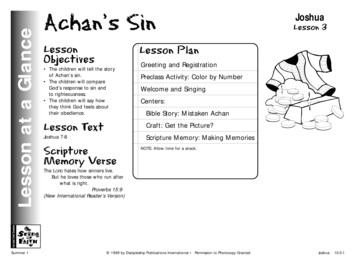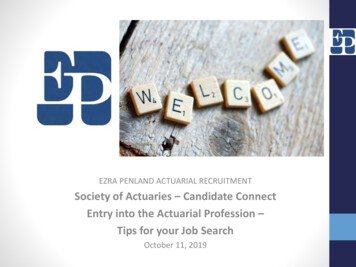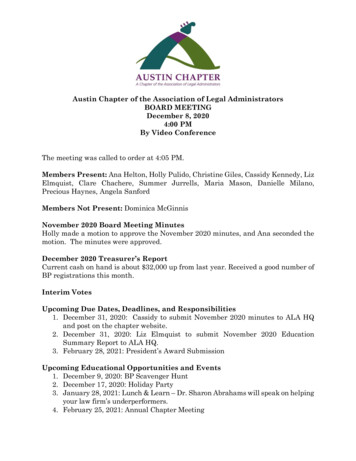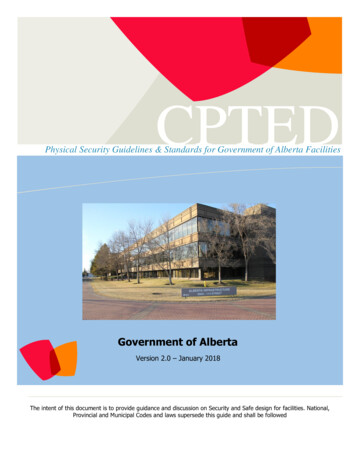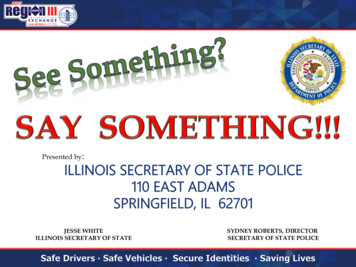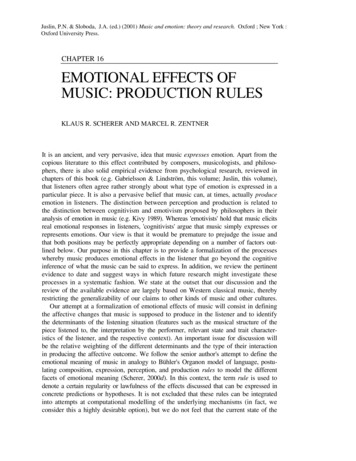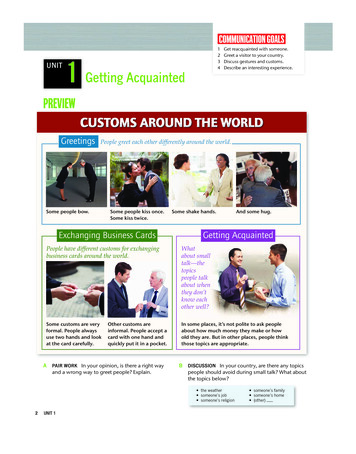
Transcription
LESSONUNIT11communication goals1234Get reacquainted with someone.Greet a visitor to your country.Discuss gestures and customs.Describe an interesting experience.Getting AcquaintedpreviewGreetingsPeople greet each other differently around the world.Some people bow.Some people kiss once.Some kiss twice.Exchanging Business CardsPeople have different customs for exchangingbusiness cards around the world.Some customs are veryformal. People alwaysuse two hands and lookat the card carefully.Other customs areinformal. People accept acard with one hand andquickly put it in a pocket.A PAIR WORK In your opinion, is there a right wayand a wrong way to greet people? Explain.Some shake hands.Getting AcquaintedWhatabout smalltalk—thetopicspeople talkabout whenthey don’tknow eachother well?In some places, it’s not polite to ask peopleabout how much money they make or howold they are. But in other places, people thinkthose topics are appropriate.B DISCUSSION In your country, are there any topicspeople should avoid during small talk? What aboutthe topics below? the weather someone’s job someone’s religion2And some hug. someone’s family someone’s home (other)UNIT 1M01 TOPN TE 02 0462 U01.indd 211/25/14 1:42 PM
UNIT1Getting AcquaintedpreviewB DiscussionBefore Exercise A , give students a few minutes to silentlyread and examine the photos and information aboutcustoms. Ask a volunteer to read the heading Customs Aroundthe World. Call on students to read the section headings and thephoto descriptions. To focus on Greetings, ask students for additional waysto greet people and write them on the board. (Possibleresponses: Pat on the back, nod, smile.) Focus on Getting Acquainted. Explain that small talk isconversation about minor topics. Ask students to nameadditional topics that can be used for small talk. (Possibleresponses: the weather, hobbies, work.)Suggestedteaching time:7–12minutesYour actualteaching time: Model the activity by discussing the questions with amore confident student. Review the question and topicsin the box with the class. Encourage students to fill in theblank with another conversation topic. Divide the class into groups of three and have studentsread and discuss the questions. Move around the roomand help students as needed. Review answers with the class. Ask Which topics would youfeel uncomfortable talking about? Most comfortable? Whatother topics did you think of?Language and culture* Customs vary from culture to culture. In Japan,business cards are always presented to another personwith two hands to show respect. In English-speakingcountries, hugging or kissing is reserved for friends orclose associates. In some cultures, asking about a person’sage or salary is acceptable; in English-speaking countries,asking about age or salary can be rude.*Language and culture notes are provided to offerstudents enrichment or more information aboutlanguage and / or culture. Their use is optional.A Pair workSuggestedteaching time:3minutesYour actualteaching time: For a warm-up, ask How do you usually greet people? On the board, write What behaviors would be unusual Have pairs discuss the questions; then call on students toshare their opinions with the class.or strange in your country? Why?UNIT 1, PREVIEWM01 TOPN TE 02 0462 U01.indd T2T211/25/14 1:42 PM
C1:02Suggestedteaching time: D Focus on languagePhoto story10–15minutesTo prepare students for the activity, have them look at thephotos. Ask:Do you think the two men know each other well? (No.)How do they greet each other in the second photo? (Byshaking hands.)How do they exchange business cards? (Taka uses twohands to hold the card.) Have students read and listen to the conversation once ortwice. To check comprehension, ask:What countries are Leon and Taka from? (Mexico, Japan.)Where did they meet last week? (At an IT businessconference.)Where is the conference going to be next year? (Acapulco.) IT refers to information technology. What have you been up to? means What have you beendoing? and is commonly used in spoken English. Theexpression can be used in different tenses; for example,What are you up to these days? What were you up to?Option: ( 5 minutes) To extend the activity, have pairs roleplay the Photo Story. Tell them to replace the names in thebook with their own names.Option: ( 10 minutes) To challenge students, have themcreate and role-play their own conversations using theunderlined expressions from the exercise. Tell them toimagine they met some time in the past and that now theymeet again. For example,A: You look familiar. I’m.B: Oh, yes, I think we met atlast week. I’m.Volunteers can presenttheir role play to the class.pENGLISH FOR TheT box at the top of this page, titledTODAY’S WORLD “Englishfor Today’s World,” indicates that“one or bothb th off theth speakers in the Photo Story is not a“native speaker” of English. Remind students that in today’sworld, they must learn to understand both a variety ofstandard and regional spoken native accents as well asnon-native accents because most English speakers in theworld are not native speakers of the language. Languagebackgrounds are shown in the box so you can point themout to students.FYI: The subtitle of the Top Notch series is English forToday’s World. This is in recognition of the fact that Englishis a language for communication between people from avariety of language backgrounds.5minutesYour actualteaching time: To prepare students, point out the underlined expressionsin the Photo Story. Ask volunteers to read them aloud. Model the activity by doing the first item. After students do the matching, have them compareanswers in pairs. Move around the room and help students as needed.E Think and explainSuggestedteaching time:5minutesYour actualteaching time: Tell students to make notes as they think about andanswer the questions. Encourage them to use theunderlined expressions from the Photo Story in theiranswers. Point out that the quote to the right shows a sampleanswer for item 1. Review answers with the class.Listen again and review answers with the class.Language and cultureT3Suggestedteaching time:Your actualteaching time:Answers to Exercise E1. He thinks he recognizes him.2. No. He hasn’t been doing much.3. So that they can keep in touch.4. To show Taka around in Acapulco.SPEAKINGPair workSuggestedteaching time:10–15minutesYour actualteaching time: Ask students to read the sample advice in the quotesaloud. Explain vocabulary as needed. Ask Who agrees witheach statement? Have students work in pairs. As pairs write their advice,move around the room to provide help with vocabularyand expressions. Tell students to use the same languageto give their advice; for example, Please don’t . . . ;Never . . . Invite students to share their advice with the class andexplain why it is important. Ask the class Did you find anyone’s answers surprising?Whose?extrasWorkbookUNIT 1, PREVIEWM01 TOPN TE 02 0462 U01.indd T311/25/14 1:42 PM
ENGLISH FOR TODAY’S WORLDC1:02PHOTO STORY Read and listen to two people meeting in a hotel lobby.Leon: You look familiar. Haven’t wemet somewhere before?Taka: I don’t think so. I’m not fromaround here.Leon: I know! Aren’t you from Japan?I’m sure we met at the IT conferencelast week.Taka: Of course! You’re from Mexico,right?Leon: That’s right. I’m sorry. I’veforgotten your name.Taka: Kamura Takashi. But you cancall me Taka.Leon: Hi, Taka. Leon Prieto. Pleasecall me Leon. So, what have youbeen up to since the conference?Taka: Not much. Actually, I’m on myway to the airport now. I’m flyingback home.Understand English speakers fromdifferent language backgrounds.Leon Spanish speakerTaka Japanese speakerLeon: Hey, we should keep in touch.Here’s my card. The conference isin Acapulco next year and I couldshow you around.Taka: That would be great. I hearAcapulco’s beautiful.Leon: It was nice to see you again,Taka.Taka: You, too.D FOCUS ON LANGUAGE Find the underlined expression in the Photo Story that matcheseach explanation.1 You say this when you want to offer to introduce someone to a new place. I could show you around.2 You say this to suggest that someone call or e-mail you in the future. We should keep in touch.3 You say this when you’re not sure if you know someone, but you think you might. You look familiar.4 You say this when you want to ask about someone’s recent activities. What have you been up to?ETHINK AND EXPLAIN Answer the questions, according to the Photo Story. Explain your answers. See page T3“1 Why does Leon begin speaking with Taka?2 Has Taka been busy since the conference?3 Why does Leon give Taka his business card?Because he thinks he knows Taka.He says, ‘You look familiar.’”4 What does Leon offer to do at the next conference?SPEAKINGYour advicePAIR WORK With a partner, discuss and writeadvice for visitors about how to behave in yourcountry. Then share your advice with the class.“123Questions like How old are you? andHow much money do you make? aren’tpolite. You shouldn’t ask them.” “Don’t exchange business cards withone hand! Always use two hands.”UNIT 1M01 TOPN TE 02 0462 U01.indd 3311/25/14 1:42 PM
LESSONgoal1Get reacquainted with someoneGRAMMAR The present perfectFor regular verbs, the past participle formis the same as the simple past form.open openedstudy studiedUse the present perfect to talk about an indefinite time in the past.Form the present perfect with have or has and a past participle.Affirmative and negative statementsWe ’vemet them.haven’tYes / no questionsA: Have you met them?B: Yes, we have. / No, we haven’t.’shasn’tShecalled him.A: Has she called him?B: Yes, she has. / No, she hasn’t.Remember: Use the simple past tense to talk about adefinite or specific time.present perfect: indefinite timesimple past tense: definite timeI’ve met Bill twice.We met in 1999 and again in 2004.Contractions’ve met have methaven’t met have not met’s met has methasn’t met has not metGRAMMAR BOOSTER p. 126 The present perfect: informationquestionsA Choose the correct form to complete each sentence.1 We’vea takeIrregular verbsbase form simple past past participlebewas / enFor more irregular verb forms, see page 123.the 2:00 express train many times.b tookc taken2 I had breakfast at 9:00, but I haven’ta haveb hadc having3 Alison hasa wentlunch.to the mall.b gonec go4 My younger brother hashome from work.a comeb camec comes5 They posted some messages yesterday, but they haven’ta writtenb writec wroteanything about their trip.B PAIR WORK Complete the conversations with the present perfect or thesimple past tense. Then practice the conversations with a partner.Has Jake met1 A:our new teacher?Jake / meethe hasB: Yes,Have they been2 A:met. Hethey / beher in the office this morning.meetto this class before?B: No, they haven’t . They’re new at this school.Have you eaten3 A:you / eatI haven’tB: No,in the new school restaurant?. Is it good?Have your classmates spoken4 A:your classmates / speakwith the school director?B: Yes, they have . They5 A:Has Beth seenBeth / seespeakwith her yesterday.the new language lab?B: No, she hasn’t . But she4spokehas seenseethe library.UNIT 1M01 TOPN TE 02 0462 U01.indd 411/25/14 1:42 PM
LESSON1AGRAMMARSuggestedteaching time: Suggestedteaching time:10–15minutesYour actualteaching time:To introduce the structure, write on the board 1 They’vemet before. 2 She met him yesterday. Ask:Which sentence mentions specific time in the past?(Number 2, yesterday.)What is the verb in sentence 2? (Met.)What tense is the verb? (Simple past tense.)Write simple past tense above the sentence.present perfect because it does not mention a specific timein the past. We don’t know exactly when she met him. To help students identify the difference between specificand non-specific times, explain that a specific time tellsthem when something happened. Practice this conceptby presenting pairs of sentences and asking if the time isspecific. For example, I’ve read that book. Is this specific?(Non-specific—at some time in the past.) I read that booklast week. (Specific—last week.)Go over the information about statements and yes / noquestions in the Grammar box. Ask volunteers to read theexample sentences. Ask Which verb is regular? (Called.)What is the base form of this verb? (Call.) Which verb isirregular? (Met.) What is the base form of this verb? (Meet.) Ask a student to read the Remember note in the Grammarbox. Point out the specific time references in the simplepast tense (1999, 2004). Make sure students understandthe meaning of indefinite (non-specific) and definite(specific). Explain that the example in the present perfectdoes not have a definite time reference. We don’t knowwhen this person has met Bill. Ask a student to read the Remember note in the Grammarbox. Point out the specific time references in the simplepast tense (1999, 2004). Make sure students understandthe meaning of indefinite (non-specific) and definite(specific). Explain that the example in the present perfectdoes not have a definite time reference. We don’t knowwhen this person has met Bill. Review the formation of the simple past; remind studentsthat regular verbs form the simple past tense by adding-ed to the base form. The past participle form is the same.Explain that irregular verbs do not form the simple pasttense by adding -ed. The past participle form may be thesame as the simple past form or different. Direct students’ attention to the information in theContractions box. Point out the contractions in all theexample sentences and ask students to give the full formfor each (have–have not; has–has not). Be sure to explainthat short answers in the present perfect only contractthe negative form.5–10minutesYour actualteaching time: Remind students that with the present perfect, the pastparticiple form follows have or has. Review answers as a class.B Pair workSuggestedteaching time:5–10minutesYour actualteaching time: To prepare students for the activity, tell them to circle thedefinite past time references to help them identify thesentences that use the simple past tense (1B this morning;4B yesterday). Point out the list of simple past forms and past participlesfor irregular verbs in the Grammar box. Remind studentsnot to include the past participle in the short answers. After pairs have compared answers, have volunteers readthe conversations aloud to the class.Read the underlined verb in the first sentence. Then writepresent perfect above it. Explain that this sentence uses the Choose the correct form . . .Language and culture In British English, the past forms of some words can beeregular or irregular. For example, you can say burned orburnt, learned or learnt, spelled or spelt. The regular pastforms of these words are always used in American English. The past participle of get is got in British English; inAmerican English, the past participle of get is gotten.Option: ( 10 minutes) To challenge your students, havethem work in pairs to prepare two short conversations.Tell students to use the present perfect in the questionand the simple past tense or the present perfect in theresponse. Move around the room to provide help andanswer questions. After finishing, have pairs role-play theirconversations for the class. Ask the class to listen for theverb form and any definite time references in the response.After all the pairs have finished, review the verbs with theclass.Option: GRAMMAR BOOSTER (Teaching notes p. T126)Inductive Grammar ChartsUNIT 1, LESSON 1M01 TOPN TE 02 0462 U01.indd T4T411/25/14 1:42 PM
C Grammar practiceSuggestedteaching time:5minutesYour actualteaching time: To help students identify which sentences require thesimple past tense, tell them to circle the definite past timereferences. (1. This morning; 3. In 2013; 7. Last September) Have students compare answers in pairs. Review answers with the class. Refer to the Grammar boxon page 4 if needed.Extra Grammar ExercisesCONVERSATION MODELA 1:03 Read and listen . . .Suggestedteaching time:2minutesYour actualteaching time:These conversation strategies are implicit in the model: Use “I don’t think so” to soften a negative answer. Say “I know!” to exclaim that you’ve discovered ananswer. To prepare students for the activity, ask What’s happeningin the picture? (A man is introducing two women.) Is this abusiness or a social situation? (Social.) After students read and listen to the conversation, makesure they understand the conversation strategies byasking comprehension questions; for example, DoesAudrey recognize Hanah right away? (No.) Does Hanahrecognize Audrey? (Yes.)B1:04Rhythm and intonationSuggestedteaching time: 3minutesPRONUNCIATIONA 1:05 Listen to how the sound . . .3minutesYour actualteaching time:Pronunciation Coach Video After students have listened to and read the sentences, tellthem to listen again, paying attention to the disappearing/t/ sound of the negative contraction.Have students listen a third time and repeat in the pauses.BNow practice saying . . .Suggestedteaching time: 2minutesT5Your actualteaching time:For more practice, have pairs say the sentences to each other.Listen for correct sound reduction. Provide help as needed.Pronunciation ActivitiesConversation activatorSuggestedteaching time:13–18minutesYour actualteaching time:Conversation Activator Video Note: You can print the script or you can show a runningtranscript on video player on the ActiveTeach. The scriptalso appears on page 181 of this Teacher’s Edition. To review getting reacquainted with someone, referstudents to the Conversation Model. Ask a volunteer to read the Ideas list. Ask Which of theseplaces do you go to often? Why? At which places do youusually meet new people? Have students fill in their own idea and share answerswith the class.don’t stop! Extend the conversation. Encourage studentsto continue the conversation by using topics in the box. For more support, play the Conversation Activator Videobefore students do this activity themselves. In Scene 1,the actors use different words in the gaps from the onesin the Conversation Model. In Scene 2, the actors extendthe conversation. After each scene, ask students how themodel has been changed by the actors. Be sure to reinforce the use of conversation strategies. Onthe board, write Body language. Demonstrate the use ofappropriate gestures and facial expressions; for example,looking puzzled when responding “I don’t think so . . .”to the question Have we met before? Model the activity by role-playing with a more confidentstudent. Take the role of Student A and use studentnames; for example, Peter, have you met Mary? Thenextend the conversation by using a situation from theIdeas and Don’t stop! boxes. Divide the class into groups of three. Tell students to fillin the blanks and continue the conversation. Encouragestudents to refer to the Ideas list for places where theymight have met. Move around the room and help students as needed. Remindthem that small talk is conversation about minor topics. Make sure students change roles and start a newconversation at least once.Your actualteaching time:Have students repeat each line chorally. Make sure they:use rising intonation for . . . have you met Hanah?use falling intonation for . . . I’d like you to meet Audreyand How have you been?Suggestedteaching time:now you can Get reacquainted with someoneOption: ( 10 minutes) To expand the activity, ask groups toperform their introductions. Have other groups write down thebody language they observe. To demonstrate, write StudentA stood very close to Student B. Student B moved hishands around a lot. Student A smiled and looked friendly.After each introduction, ask Was the person introduced using afirst or last name? How did the people greet one another?Conversation Activator Video Script; ConversationActivator Pair Work CardsextrasWorkbook or MyEnglishLabSpeaking Activities: Unit 1, Activity 1UNIT 1, LESSON 1M01 TOPN TE 02 0462 U01.indd T511/25/14 1:42 PM
C GRAMMAR PRACTICE Complete the message with the present perfect or the simple past tense.New TabAboutFriendsPhotosNew messageHello, Mr. Kemper:VideosOctober 66:00 PMRemember me? I’m Kuai, your former student! I still think about your wonderful English classes indecided to send you a message to say hello. We (2 not see)have not seen each other in a long time—not since you went back home to New York. I hope I can visit youShanghai. This morning, I (1 decide)there some day! So let me tell you what I’ve been up to. In 2013, I (3 come)cameto Canada formy studies, and I’m living in Vancouver right now. I (4 fall) have fallen in love with this city—it’s reallybeautiful! I (5 visit) have visited a lot of places in the U.S. I (6 be) have been to Seattle, Portland,San Francisco, and Los Angeles. Last September, I (7 go)Kuai YuStatus: singleHometown: ShanghaiCurrent city: VancouverDIGITALwentback home to Shanghai tovisit my parents. Do you think my English is better now? I think I (8 learn) have learned how to use thepresent perfect, ¿nally! Let’s keep in touch. If you come to Vancouver, I’d love to show you around.Your student, KuaiMOREEXERCISESCONVERSATION MODELA1:03Read and listen to people getting reacquainted.A: Audrey, have you met Hanah?B: No, I haven’t.A: Hanah, I’d like you to meet Audrey.C: Hi, Audrey. You look familiar. Have we met before?B: I don’t think so.C: I know! Last month. You were at my sister Nicole’s party.B: Oh, that’s right! How have you been?BDIGITALVIDEOCOACHRHYTHM AND INTONATION Listen again and repeat.Then practice the Conversation Model with a partner.1:04PRONUNCIATION Sound reduction in the present perfectA1:05 Listen to how the sound /t/ of the negative contraction“disappears” in natural speech. Then listen again and repeat.1 I haven’t/ been to that class.3 They haven’t/ taken the test.2 He hasn’t/ met his new teacher.4 She hasn’t/ heard the news.B Now practice saying the sentences on your own.now you canDIGITALVIDEOGet reacquainted with someoneCONVERSATION ACTIVATOR With two other students, practice making introductions andgetting reacquainted. Use your own names and the present perfect. Then change roles.A:, have you met?B: No, I haven’t.A:, I’d like you to meet.C:. You look familiar. Have we met before?B:.don't stop! Say how you have been. Say more about the time you met. Introduce other classmates.IdeasYou met at a party at a meeting at a friend’s house in another class (your own idea)UNIT 1M01 TOPN TE 02 0462 U01.indd 5511/25/14 1:42 PM
LESSON2goalGreet a visitor to your countryThe ForbiddenPalaceCONVERSATION MODELA1:06Read and listen to someone greeting a visitor.A: Welcome to Beijing. Have you ever been here before?B: No, it’s my first time. But yesterday I went to theForbidden Palace. It was fantastic!A: That’s great. Have you tried Beijing duck yet?B: Beijing duck? No, I haven’t. What’s that?A: It’s a famous Chinese dish. I think you’ll like it.B1:07 RHYTHM AND INTONATION Listen again and repeat.Then practice the Conversation Model with a partner.Beijing duckDIGITALFLASHCARDSVOCABULARY Tourist activities around the worldA1:08Read and listen. Then listen again and repeat.climb Mt. Fujigo sightseeing in New Yorkgo to the top of the Eiffel Towertry Korean foodtake a tour of the Tower of Londontake pictures of the Great WallB PAIR WORK Use the Vocabulary to say what youhave and haven’t done.“I’ve climbed twofamous mountains.GRAMMAR The present perfect: already, yet, ever, before, and neverUse ever or before in yes / no questions about life experiences.Have you ever eaten Indian food?Has he been to Paris before?” “I haven’t triedIndian food.”Be careful!I have never (OR haven’t ever) been there.NOT I haven’t never been there.Use yet or already in yes / no questions about recent experiences.Have you toured Quito yet?Has she already been to the top of the Eiffel Tower?In affirmative and negative statementsWe’ve already seen the Great Wall.We haven’t tried Beijing duck yet.They have never visited Mexico.They haven’t ever visited Mexico.He’s been to New York before.He hasn’t been to Boston before.Always place before and yet at the end of statements and questions.GRAMMAR BOOSTER p. 126 Yet and already: expansion, common errors Ever, never, and before: use and placement6M01 TOPN TE 02 0462 U01.indd 611/25/14 1:42 PM
LESSON2B Pair workCONVERSATION MODELA 1:06 Read and listen . . .Suggestedteaching time:2minutes Have students look at the pictures on the right. Ask Whatcity is this? (Beijing.) What are the two people doing?(Shaking hands and introducing themselves.) After students listen and read, ask comprehensionquestions: Has the man been to Beijing before? (No.) Wheredid he go yesterday? (To the Forbidden Palace.) Point out that Beijing duck is a famous Chinese dish. Point out that the expression been to a place only occursin the present perfect. It is a very common way of sayinghave visited a place.1:07Rhythm and intonationWrite on the board What tourist activities have youdone? and Which haven’t you done? Read eachquestion aloud. Model the activity by providing one ortwo of your own answers. Have students work in pairs toanswer the questions using the vocabulary and their owninformation. Remind them to use the present perfect. As pairs are discussing their answers, move around theroom and help students as needed. To review answers, have individuals report to the class atourist activity that their partner has done; for example,Ken has gone to the top of the Eiffel Tower.Option: ( 5 minutes) Have students use the bold words inthe Vocabulary to talk about other tourist activities theyhave done; for example, I have gone sightseeing in Madrid. Ihave taken pictures of the Brooklyn Bridge.GRAMMARSuggestedteaching time:7minutesYour actualteaching time: To introduce the use of yet and already, write the second lineof examples from the Grammar box on the board. Underlineyet and circle already in the questions. Ask a student toread aloud the rule and examples while you point out theplacement of yet at the end of the sentence and alreadybefore the past participle. Stress that each question is aboutactivities a person has or hasn’t done a short time ago. Invite volunteers to give the location of the placespictured, or tell students where they are. (Mt. Fuji—Japan;Statue of Liberty—New York; Eiffel Tower—Paris; Tower ofLondon—England; the Great Wall—China)Ask volunteers for additional questions with yet. Havestudents answer in the affirmative or negative using yet oralready; for example, Have you seen this movie yet? (Yes, Ihave already seen it. No, I haven’t seen it yet.). Ask What are the tourists pointing to in the second picture?(The Statue of Liberty.)Explain that yet, already, and ever are optional. Theyemphasize the lack of a specific time reference. Have students underline the affirmative statements.(We’ve already seen the Great Wall; He’s been to NewYork before.) Point out that They have never and Theyhaven’t ever have the same meaning. Direct students’attention to the Be careful! box. Remind them that neveralways follows an affirmative verb.Your actualteaching time:Have students repeat each line chorally. Make sure they:use rising intonation for Have you ever been here before?and Have you tried Beijing duck yet?use falling intonation for What’s that?Suggestedteaching time:2minutesYour actualteaching time:Vocabulary Flash Card Player Your actualteaching time:Write on the board the examples under the first rule.Explain that before means before now and refers to anindefinite time in the past. Point out that ever is placedbefore the past participle, and before is placed at the endof the sentence. Point out that ever and before can beused in the same sentence: Have you ever been to Londonbefore? Then have students read the Be careful! note.3minutesVOCABULARYA 1:08 Read and listen . . . 5minutes Suggestedteaching time: Your actualteaching time:These conversation strategies are implicit in the model: Use “Welcome to” to greet someone to a new place. Say “That’s great” to acknowledge someone’s positiveexperience.BSuggestedteaching time:Language and culture From the Longman Corpus: A common mistake byEnglish learners of all language backgrounds is to say dosightseeing instead of go sightseeing. However, do somesightseeing is a common expression in spoken English.Learning StrategiesLanguage and culture In British English, the present perfect is used with apast action that has a result in the present; for example,David has lost his keys. In American English, the presentperfect and the simple past are both used, but the simplepast is more common; for example, David lost his keys.Option: GRAMMAR BOOSTER (Teaching notes p. T126)Inductive Grammar ChartsUNIT 1, LESSON 2M01 TOPN TE 02 0462 U01.indd T6T611/25/14 1:42 PM
A Grammar practiceSuggestedteaching time: 3minutesYour actualteaching time:Model the activity by doing the first item with the classand writing it on the board. Then ask several students thequestion. Remind them to use the present perfect in theiranswer. As students write the statements and questions, movearound the room. Review the statements and questions with the class.B1:09 Extra Grammar ExercisesLearning Strategiesnow you can Greet a visitor to your countryA NotepaddingListen to activate grammarSuggestedteaching time:8–10minutesYour actualteaching time:To prepare students for the activity, tell them to lookat the pictures and read the captions. If students don’tknow, explain that ceviche is raw fish marinated in lemonjuice, oil, and spices.Have students work in pairs to ask each other theirquestions. Remind students to use the present perfect intheir answer.Suggestedteaching time: 5–10minutesYour actualteaching time:Ask students for examples of tourist activities and populardishes and drinks in their country. Make a list on theboard of the most popular items.B Conversat
1 You say this when you want to offer to introduce someone to a new place. 2 You say this to suggest that someone call or e-mail you in the future. 3 You say this when you’re not sure if you know someone, but you think you might. 4 You say this when yo
